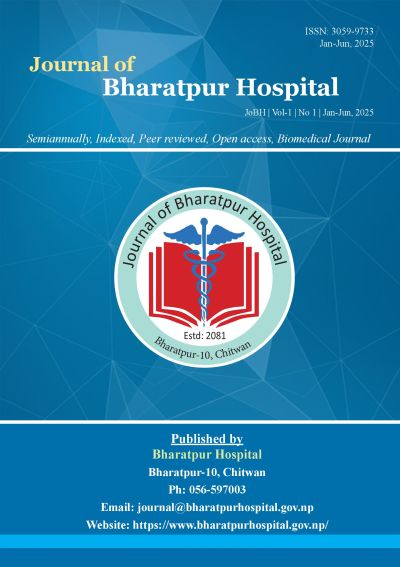Blepharophimosis Syndrome
DOI:
https://doi.org/10.3126/jobh.v1i1.78519Keywords:
Blepharophimosis syndrome, BPES, palpebralAbstract
Blepharophimosis syndrome (BPES) is a rare congenital condition primarily affecting the eyelids, leading to distinctive facial features. It is characterized by bilateral ptosis (drooping of the upper eyelids), shortened horizontal palpebral fissures (narrowed eye openings), epicanthus inversus (an upward fold of skin near the inner corner of the eye), and telecanthus (increased distance between the inner corners of the eyes). These features can significantly impact both vision and facial aesthetics. BPES is classified into two types based on its associated systemic manifestations. Type I BPES is linked to premature ovarian insufficiency (POI), which can result in infertility in affected females. In contrast, Type II BPES presents without ovarian involvement, primarily affecting only the eyelids. The condition is caused by mutations in the FOXL2 gene, which plays a crucial role in eyelid and ovarian development. Genetic testing is essential for confirming the diagnosis and guiding management, particularly in distinguishing between the two types. A multidisciplinary approach is vital in the evaluation and management of BPES. Ophthalmologic assessment is necessary for determining the extent of eyelid malformation and planning surgical correction. Genetic counseling is recommended for affected families, particularly for females with Type I BPES due to reproductive implications. Endocrinologic evaluation may also be required to assess ovarian function. Early surgical intervention, such as frontalis suspension or eyelid reconstruction, can significantly improve visual function and cosmetic outcomes. Regular follow-up is crucial to monitor for potential complications and ensure optimal management of both ocular and systemic aspects of the condition.
Downloads
Downloads
Published
How to Cite
Issue
Section
License
Copyright (c) 2025 The Author(s)

This work is licensed under a Creative Commons Attribution-NonCommercial-NoDerivatives 4.0 International License.
This license enables reusers to copy and distribute the material in any medium or format in unadapted form only, for noncommercial purposes only, and only so long as attribution is given to the creator.




